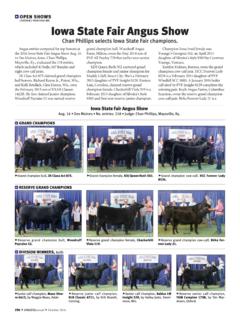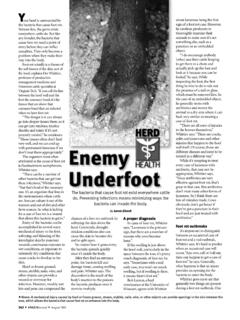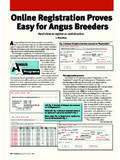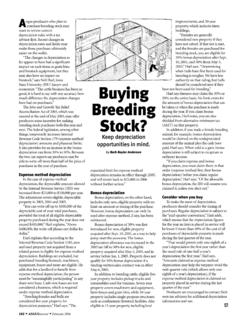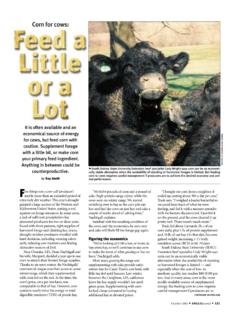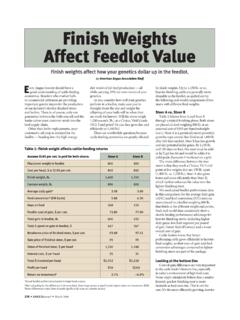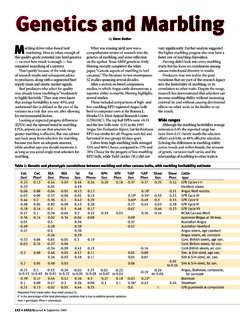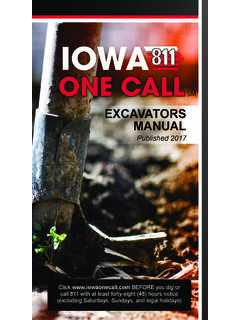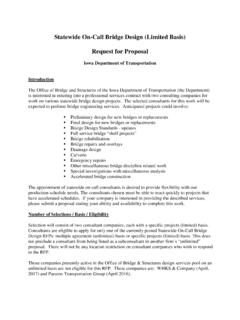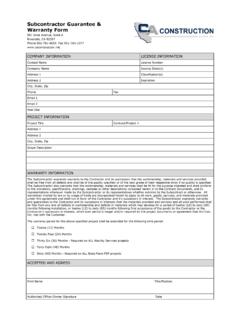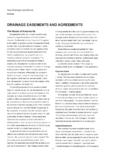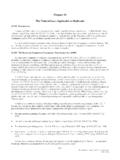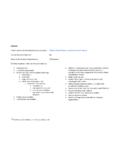Transcription of Livestock Fence and the Law - Angus Journal
1 Our recent series of articles has discussed various Fence -building considerations, but it s also important for Livestock owners to think about whether their existing fences, or the fences they are planning to construct, comply with the law. Some Livestock owners may be unaware that state laws prescribe when a Fence is required, what kind of Fence it should be, and who has responsibility for building and maintaining it. Familiarity and compliance with requirements for a lawful or legal Fence could help Livestock owners avoid disputes with neighboring landowners and might also help minimize liability many states have relatively few state statutes pertaining to agricultural issues, every state has a Fence law statute, says University of Missouri (MU) Emeritus Professor Stephen Matthews, director of the Missouri Agricultural Law Center.
2 The original colonies adopted the English Common Law, Matthews explains. Common Law, or case-made law, put the burden of responsibility on Livestock owners to keep their animals from trespassing on a neighbor s property. However, some states departed from Common Law, requiring crop farmers to Fence their fields to keep free-ranging cattle out. While states often first defined open range by statute, in doing so they necessarily defined how a crop farmer could lawfully erect a lawful Fence and thus be allowed to collect damages or apply other remedies (impound or kill trespassing Livestock )
3 If he first protected his land with a lawful Fence , Matthews differThe definition of a lawful Fence varies considerably among states and may include specific descriptions of acceptable fences constructed of rails, boards and stone, and fences incorporating natural barriers such as cliff walls or bluffs. Even the requirements for a lawful barbed-wire Fence are variable from state to some states , a legal barbed-wire Fence must be at least 36 inches (in.) high, while others call for minimum heights of 48 or 52 in. The minimum number of strands of barbed wire required can vary from three to as many as eight.
4 Some state codes require spacing between the wires to meet specific measurements. Requirements may call for Fence posts to be placed at intervals of 20 feet (ft.), one rod ( ft.) or other distances, sometimes depending on whether stays or pickets are used between posts. Different Livestock species often are addressed, with different requirements for hog- or sheep-tight Fence than for cattle, horses and state Fence laws are more subjective. In some New England states , for example, the law reads as follows: All fences four feet high and in good repair, consisting [of] rails, timber, stone walls, iron or wire, and brooks, rivers, ponds, creeks, ditches and hedges, or other things which in the judgment of the Fence viewers having jurisdiction thereof are equivalent thereto, are legal and sufficient fences.
5 In states requiring the services of Fence viewers, the duty may go to local elected officials or, by appointment, to Fence -savvy persons. It s their job to determine if new fences are legal and to arbitrate Fence -related every state, however, plenty of fences on Livestock operations fall short of specifications set down in law. In many cases, that s okay. The laws do not pertain to fences that subdivide a landowner s pastures and fields. They do apply to boundary fences, and certainly those that serve as a partition between properties of neighboring landowners.
6 And it s over these fences that neighbors sometimes problems arise In my opinion, based upon 35 years of Extension work and fielding fencing questions, says Matthews, the most common Fence disputes are over Fence boundaries, maintenance of existing Fence and the replacement of an old Fence . According to Matthews, disputes over placement of an existing Fence may arise when a piece of real estate changes hands and a land survey is performed to determine actual boundaries for the property. A survey may reveal that an existing boundary Fence really doesn t stand on the property line, but some distance to one side or the other.
7 If the buyer of the property feels he is giving up too much of his newly acquired land to a neighbor, he may want the Fence moved to align with the surveyed boundary. That might be agreeable to the neighbor, or it may not. If that neighbor has actually been using the land gained because of Fence placement, for a long enough period of time, he may be able to claim it through the doctrine of adverse possession, which is observed in all 50 states . It basically means, states Matthews, an existing Fence (that the previous landowner and the neighbor) regarded as being on the lawful boundary for a statutorily prescribed minimum of time, that such Fence will re-establish the lawful boundary line.
8 states vary in the time required before someone can assert a claim of adverse possession. It may be as few as two years or as many as 60 landowners sometimes disagree over who has responsibility for building and maintaining fences. The answer, found in their state s Fence law, depends on whether it is a Fence -in or Fence -out jurisdiction. Most states are Fence -in jurisdictions 94 n AngusJournal n June 2010 Livestock Fence and the Law Know where you stand when it comes to fencing Troy Smith FENCING FUNDAMENTALS: PART 6In an increasingly litigious society, the construction and maintenance of good fences represents an investment in risk , says Roger McEowen, director of the Center for Agricultural Law and Taxation, iowa State University.
9 That means Livestock owners are responsible for fencing in their Livestock . In Fence -out or open-range jurisdictions, crop farmers and other landowners must use fences to keep Livestock out. In application, it s not quite that simple. Statutes often require neighbors to share responsibility for maintaining boundary fences, even if one of them doesn t have Livestock , McEowen adds. That surprises a lot of people, but it s that way in most of the major Livestock -producing states . In such instances, landowners might be required to share equally the cost of maintaining a boundary Fence .
10 Or, the law may state that each landowner is responsible for maintaining half of the Fence specifically, that half which lies to his right when he stands on his side of the Fence , at the midway point and facing the , each party is responsible for the cost of the prescribed share of a legal Fence , as defined by law. You only have to pay for your share of a Fence meeting minimum requirements, even if your neighbor wants a Fence to make an enclosure as secure as Fort Knox, McEowen state might have it both ways, with Fence -in or Fence -out status determined at the county level.
